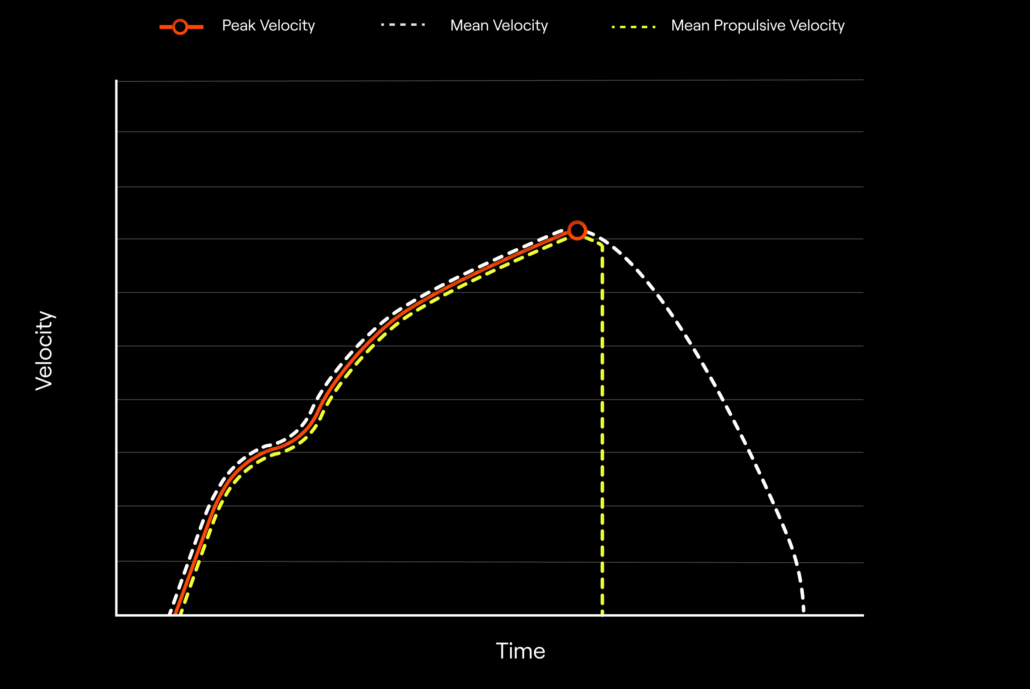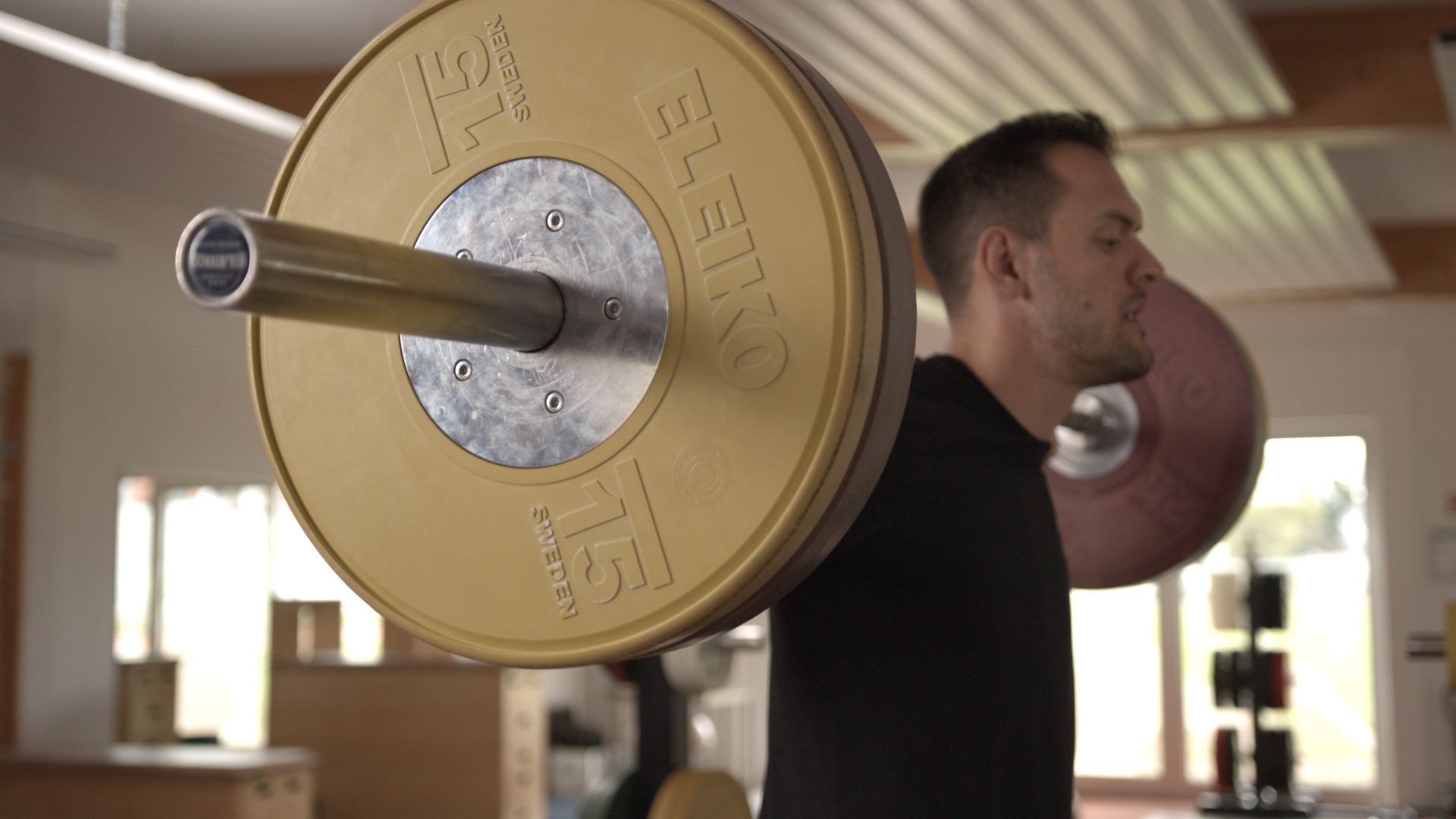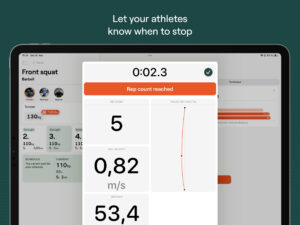Table of content
In the previous article in this series, we looked at how can we use movement velocity to monitor and prescribe resistance training, and we touched on load-velocity profiling. Before expanding on other applications, you might be asking what velocity metrics you should use. That’s a legitimate question as you’ve probably heard people talking about mean, peak, and propulsive velocity, especially in the velocity-based training (VBT) context. So, let’s cover these three velocity variables most used in practice.
Explaining the mean velocity variable
Mean velocity represents the average velocity of the entire concentric phase of the movement. If you were to visualize a velocity-time graph of your athlete or a client doing a free-weight back squat exercise you would be able to see the velocity at which your athlete was moving at every instant in time. Most devices out there recording movement velocity during resistance training do this behind the scenes, but you only get one number under “mean velocity” or “average velocity”. That number simply represents the average velocity of all instantaneous velocities (i.e., data points) recorded during the concentric phase of the exercise. In other words, the average velocity from the bottom of the squat until the barbell reaches its maximum height (or when the full extension of the hips occurs). Mean velocity is by far the most researched variable for velocity tracking during resistance training [1]. It is used for a wide range of strength exercises regardless of the modality (i.e., free-weight, machine-based, and Smith machine-based exercise). Similarly, this velocity variable has been successfully used to establish load-velocity profiles and thus adjust training loads and monitor progress, terminate training sets based on velocity loss, quantify the neuromuscular fatigue incurred in a training set, and track daily readiness to train.
Explaining the mean propulsive velocity variable
The mean propulsive velocity is another popular variable to monitor movement velocity during resistance training [2]. Just like mean velocity, this variable is also concerned with the concentric phase of the exercise. So, in the squat example from before, we’re talking about the portion of the lift between the bottom of the squat and the position where the barbell reaches maximal height (i.e., the stand-up position). The key difference between mean velocity and mean propulsive velocity variable is that mean propulsive velocity further cuts down the concentric phase of the movement and tracks the velocity until the acceleration (of the barbell, for example) is less than that of gravity (i.e., -9.81 m/s/s). In other words, mean propulsive velocity is concerned with the portion of the lift during which our athletes or clients are actively accelerating the barbell, themselves, or both in a desired direction (e.g., horizontal, or vertical). Why this might be relevant during resistance training? Well, it’s important to note that we must come to a stop to complete a repetition. Now, imagine that you or your athletes are lifting some lighter loads say 50% of 1RM. While doing so, you would spend a decent portion of the concentric phase decelerating the load, even though you are moving in the direction you want (e.g., standing up from the bottom of the squat). Think about it, if you lift submaximal loads with maximal intent (i.e., you try to move the barbell and yourself up as fast as possible during a squat), you probably won’t be accelerating yourself during the entire movement. Why is that? Well, you don’t want to leave the ground because it’s a squat exercise after all and there is probably a subconscious element to it as you want to avoid overly stressing your tendons and joints by stopping very abruptly since you know that you don’t want to leave the ground. However, it must be noted that when the load becomes reasonably heavy, say ~70% of 1RM and above, your athletes won’t spend much time (if at all) decelerating while trying to stand up in the squat exercise, for example. In this case, the mean velocity would match the mean propulsive velocity. All these considerations made some researchers [2] conclude that the mean propulsive velocity should be used instead of mean velocity, especially when assessing strength and muscle power using light and medium loads during resistance training. More about that some other time, but let’s now cover peak velocity.
Explaining the peak velocity variable
Peak velocity, compared to mean and mean propulsive velocity is the highest instantaneous velocity attained during the same concentric phase of a given exercise. It is typically much higher than the other two velocity variables we talked about. However, they all seem to correlate well with each other. Thus, if peak velocity increases, so will the mean and mean propulsive velocity. This velocity variable has been recommended for monitoring and prescribing ballistic exercises. In ballistic exercises, there is an initial rapid and powerful force followed by a projection of the body, load, or implement into the air [3]. Here, you can think of jumping, medicine ball throws, Olympic weightlifting movements, and their derivatives. Peak velocity comes in handy here because every time we are concerned with how far something will move, we need to know the exit velocity of the object (e.g., of ourselves, a ball, a barbell, you name it). This exit velocity is typically the fastest part of the movement. Hopefully, you can see how this exit velocity will correspond to peak velocity, which is the single, highest instantaneous velocity of a given movement. In summary, if we know the peak velocity of a ballistic movement, we can determine how far an object will go which is incredibly useful for monitoring and prescribing ballistic exercises. Let’s use an example of weightlifting to demonstrate this. Researchers have previously found a single moment when weightlifters hit peak velocity in both the clean and snatch [4]. This occurs at the top of the second pull. This means that if you prescribe your athletes or clients weightlifting movements, they will first accelerate up to the end of the second pull and then decelerate beyond that point. Using mean velocity, for example, would skew the measurement in this case as mean velocity looks at the average velocity of the entire concentric phase of the movement. During weightlifting movements, your athletes or clients need to lift the bar to a specific height in order to complete the lift successfully. To reach that height, the barbell must have a specific exit velocity, which is peak velocity. If you measure peak velocity, you can determine whether your athlete or client missed the lift due to technical error (e.g., necessary peak velocity was there, yet your athlete didn’t complete the lift for some reason) or the lift was just too slow, and physics made sure that your athlete fails the lift. Similar things can be said for jumping. Peak velocity during jumping occurs at the end of the “push-off” phase, which will determine the jump height, so it only makes sense to track peak velocity during jumping training as well.

Should we use all three variables to monitor and prescribe resistance training?
Ok, so which one should we use? According to the latest research [5], all three seem reliable and safe to use for load-velocity profiling which we discussed in the previous article. Additionally, you can probably now see that one can make a case for using all three velocity variables in their training and we only scratched the surface on the utility of the three popular velocity variables for resistance training monitoring and prescription in this article. Researchers still suggest that mean and peak velocity variables provide more valuable information for strength and conditioning practitioners for testing and training purposes [1]. This is probably because some researchers have shown that 1) mean velocity is slightly more reliable than mean propulsive velocity during strength training exercises [5]; and 2) mean propulsive velocity, compared to peak velocity, can include a beginning of the flight phase during ballistic exercises and thus skew the measurements [6]. Nevertheless, all three variables can find their place in your toolbox. However, if you want to simplify your monitoring procedures, considering the latest research, going with only mean and peak velocity should be more than enough to leverage the benefits of the velocity-based approach to resistance training monitoring and prescription.
References
- Weakley, J., Mann, B., Banyard, H., McLaren, S., Scott, T., & Garcia-Ramos, A. (2021). Velocity-based training: From theory to application. Strength & Conditioning Journal, 43(2), 31-49.
- Sanchez-Medina, L., Perez, C. E., & Gonzalez-Badillo, J. J. (2009). Importance of the propulsive phase in strength assessment. International Journal of Sports Medicine, 123-129.
- Baechle, T. R., & Earle, R. W. (Eds.). (2008). Essentials of strength training and conditioning. Human Kinetics.
- Harbili, E., & Alptekin, A. (2014). Comparative kinematic analysis of the snatch lifts in elite male adolescent weightlifters. Journal of Sports Science & Medicine, 13(2), 417.
- García-Ramos, A., Pestaña-Melero, F. L., Pérez-Castilla, A., Rojas, F. J., & Haff, G. G. (2018). Mean velocity vs. mean propulsive velocity vs. peak velocity: which variable determines bench press relative load with higher reliability? The Journal of Strength & Conditioning Research, 32(5), 1273-1279.
- Jaric, S., & Garcia Ramos, A. (2018). Letter to the editor concerning the article “Bar velocities capable of optimising the muscle power in strength-power exercises” by Loturco, Pereira, Abad, Tabares, Moraes, Kobal, Kitamura & Nakamura (2017). Journal of Sports Sciences, 36(9), 994-996.




